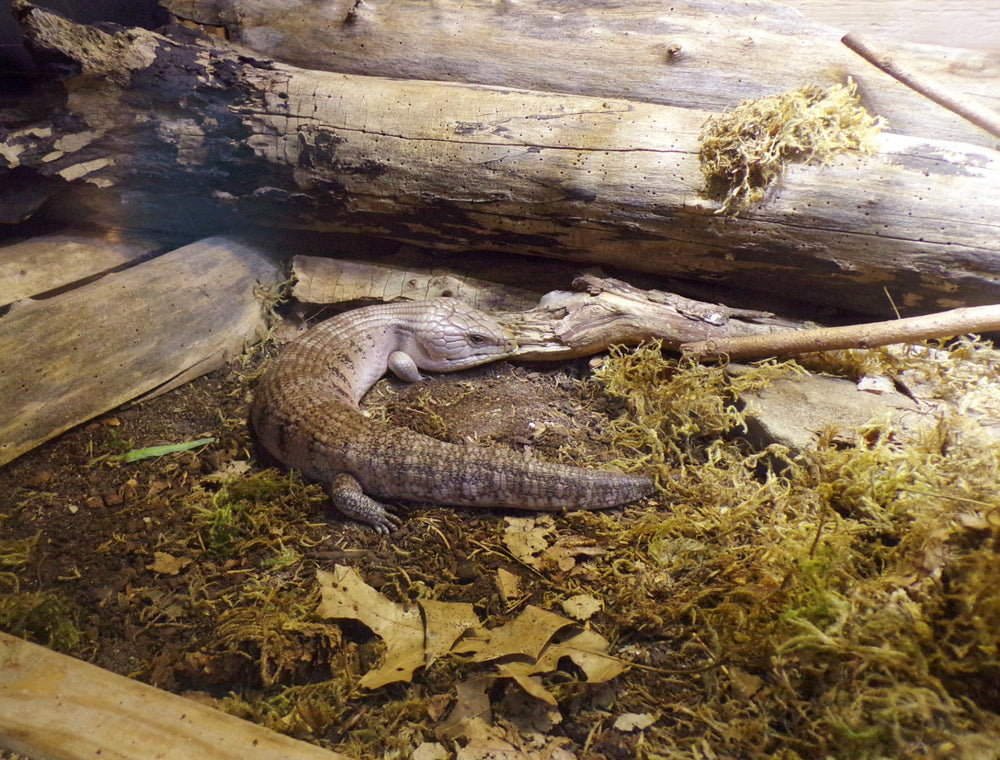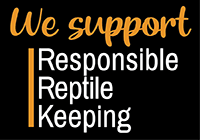Care and Maintenence of the Northern Blue Tongue Skink

Northern Blue Tongue Skink (Tiliqua scincoides intermedia)
Difficulty: Intermediate
Northern blue tongue skinks are diurnal, terrestrial lizards found in the dry forests, grasslands, and shrublands of northern Australia. They generally measure between 18-24” long at adulthood, and have an average lifespan of 15-20 years, although with good care, they can live past the age of 30.
Blue tongue skinks have thick, sausage-like bodies, short but strong limbs, and triangular heads. But their most distinctive feature is their namesake — a bright blue tongue! Although Northern blue tongue skinks produced in the US vary in appearance based on bloodline or “morph,” they generally have a gray to tan base color with darker banding along the length of the body, blotches of orange to yellow along the sides, patternless limbs, and a patternless belly. The head is typically free of markings.
Northern blue tongue skinks have become popular pets due to their generally calm and personable dispositions.
What You Need for a Bioactive Northern Blue Tongue Skink Enclosure
- 4’L x 2’W x 2’H enclosure (preferably larger)
- Exo Terra Reptile Glow Light, small, x2
- 75w Arcadia Halogen Heat Lamp, x2
- Flagstone, x1
- Two-socket rheostat
- Bio Dude Digital Thermometer / Hygrometer, x2
- 22” Arcadia Desert 12% UVB T5 HO bulb
- 24” Bio Dude Solar Grow T5 HO Single Bulb Light Strip
- Bio Dude Glow & Grow 22" LED
- Zilla 24/7 Digital Timer Power Center
- 4' x 2' x 2’ Bio Dude Terra Sahara Bioactive Kit
- Ball Python Clean Up Crew Pack
- Sturdy drought-tolerant plants
- Environmental enrichment items (hollow logs, sturdy low branches, etc.)
- Hide/cave (at least 1)
- Medium water bowl
- Repashy Calcium Plus supplement
- Zoo Med Stainless Steel 10" Curved Feeding Tongs
Terrarium Size
For housing one Northern blue tongue skink, you need an enclosure no smaller than 4’L x 2’W x 2’H, and preferably larger. Northern blue tongue skinks are known for being some of the largest in their genus, so bigger is always better!
For maximum convenience, get an enclosure that opens from the front rather than from the top. There should also be a substrate dam about 6” high to accommodate all of the soil you need for a functional bioactive setup. PVC is generally the best material for a blue tongue skink enclosure, as it’s waterproof, strong, and lightweight. However, glass or well-sealed wood are also options.
Do not house more than one Northern blue tongue skink per enclosure. Cohabiting blueys is likely to lead to conflicts, which often leads to injury, and in a worst-case scenario can result in death.
Lighting
Blue tongue skinks are diurnal, which means that they are active during the day. They are stimulated by the presence of bright light in their environment, and they require exposure to strong UVB light in order to stay healthy. Reptiles use UVB light to create the vitamin D that their body needs, as well as to strengthen their immune system, and stimulate production of endorphins. UVB even helps reduce the presence of pathogens, which is especially important for bioactive setups.
An Arcadia 12% or Zoo Med T5 HO Reptisun 10.0 is likely to work the best for a Northern blue tongue skink in a 2’ tall enclosure. The bulb should be roughly half the length of the enclosure, placed on the same side as the heat lamps, and mounted in a reflective T5 HO fixture like the Arcadia ProT5 or the Bio Dude Solar Grow light strip.
The basking branch or platform should be placed 12-15” below the lamp if there’s a mesh top, and 17-18” below the lamp if there isn’t. This is because the strength of a UVB bulb’s output changes with distance. Your UVB bulb must be replaced every 12 months to maintain its output. Resist the temptation to use other, cheaper brands — when it comes to UVB, brand matters!
Because this is a bioactive setup, you will also need a plant light to encourage healthy plant growth. We recommend at least one 22” Bio Dude Glow & Grow LED lamp or Arcadia JungleDawn LED Bar for this purpose. This bright light is also good for your bluey’s energy levels and mental health!
Lights should be kept on for 12 hours/day, or synced with your local sunrise and sunset times with a smart timer.
Heating
Like other reptiles, blue tongue skinks are poikilothermic, which means that they need a range of temperatures within their enclosure so they can regulate their own body temperature as needed. Areas of heat speed up their metabolism and promote activities like digestion and healing. Cool areas slow the metabolism and promote activities like rest and energy conservation.
Northern blue tongue skink temperature gradient:
- Basking surface temperature: 105-115°F
- Cool side temperature: 70-85°F
Turn off the heat at night to let things cool down.
To create a basking area for your blue tongue skink, you will need a cluster of at least two halogen flood heat bulbs like the 75w Arcadia Halogen Heat Lamps (optimum wattage may vary) and at least two small ceramic fixtures like the small Exo Terra Reptile Glow Light or the Zoo Med Combo Deep Dome fixture. If the basking area gets too warm, you can plug the lamps into a lamp dimmer like the Zoo Med Rheostat and reduce the heat that way. If the basking area is too cool, you will need higher-wattage bulbs.
Place one temperature probe on the basking surface and other temperature probe on the opposite of the enclosure to track your temperature gradient.
Humidity
Northern blue tongue skinks need an environment with moderate humidity levels, although they are tolerant of short periods of higher humidity. Average ambient humidity should be 40-60%, ranging lower during the day and higher at night.
Keep track of your humidity levels with a digital hygrometer like the Bio Dude Digital Thermometer / Hygrometer, with the probe placed in the middle of the enclosure. To keep track of humidity levels underground, place another probe inside one of the burrows.
Water your plants as needed in the evening to stay consistent with natural humidity cycles.
Substrate
A thick layer of bioactive-compatible substrate is essential to creating a bioactive Northern blue tongue skink enclosure. About 6” of substrate will provide plenty of space for the plants’ roots, allow for burrowing, and better facilitate a vertical moisture gradient within the substrate for your CUC (Clean Up Crew).
Because this is a temperate to semi-arid setup, no drainage layer is needed. Instead, you can jump straight to the dirt. You will need a soil-like mix that mimics the soil of their Australian homeland and nurtures temperate plants. If you want to make your own, you will need a mixture of 60% organic topsoil and 40% fine sand to total roughly 144 quarts of substrate, or 4.8 cubic feet. Mix that with leaf litter, sphagnum moss, and 4 doses of 36qt Bio Shot to inoculate your soil with beneficial microfauna.
Alternatively, you can let The Bio Dude do the work for you with The Bio Dude’s Terra Sahara bioactive substrate kit.
To make the substrate functional, make sure to add temperate CUC organisms like powder blue/orange isopods and springtails. You can also add other species like mealworms, superworms, and buffalo beetles!
Decorating the Enclosure
Enclosure décor is more than just making your setup look good. It’s also an important part of providing environmental enrichment to your lizard, which enhances your pet’s quality of life by providing opportunities to express natural behaviors. Use things like sturdy low branches, cork flats/hollows, caves, and plants to fulfill that need. Don’t be afraid to clutter it up!
Live plants in particular are critical to helping your mini-ecosystem function properly. Make sure the plants that you choose are nontoxic in case your bluey decides to take a nibble (TheTortoiseTable.org.uk is a great resource for checking plant edibility!) It’s also important to make sure that any plants you use are robust enough to handle being potentially trampled by an up to 2lb lizard, or structured to minimize this risk. Aloe, festuca grass, Mexican feather grass, snake plant, jade plant, and large elephant feed plants are likely to be suitable options for Northern blue tongue skinks.
Feeding Your Northern Blue Tongue Skink
Blue tongue skinks are omnivores, which means that they need to eat a balanced diet of animal- and plant-based foods in order to be healthy. And like humans, blue tongue skinks’ nutritional needs change as they grow. However, unlike humans, they need to eat less as they get older — not more:
- Babies (0-3 months old): daily, 70-80% protein + 20-30% plants
- Juveniles (3-8 months old): 3x/week, 70-80% protein + 20-30% plants
- Subadults and Adults (>8 months old): 1-2x/week, 50-60% protein + 40-50% plants
One portion of food for a blue tongue skink should be roughly the same size as their skull. One of the keys to success with blue tongue skinks (and most reptiles, for that matter) is to feed them as large of a variety of foods as possible!
Protein options: dubia roaches, discoid roaches, black soldier fly larvae, mealworms, superworms, hornworms, silkworms, grasshoppers, earthworms, canned snails, high-quality canned dog/cat food
Vegetable options: collard greens, cactus pads, spring mix, arugula, kale, pea shoots, alfalfa, bok choy, carrot greens, spinach, dandelion greens/flowers, hibiscus leaves/flowers
Feeder insects should be no larger than your skink’s head. ALL FEEDER INSECTS SHOULD BE LIGHTLY DUSTED WITH CALCIUM SUPPLEMENT BEFORE FEEDING, and dog/cat food should be as well. Non-citrus fruits can be offered occasionally as treats, but due to their sugar content, they should be a frequent part of your pet’s diet.
Calcium & Vitamins
To ensure that your pet is getting all the vitamins and minerals they need, you need a calcium powder and a multivitamin powder. Take care not to use too much; too much vitamins can be just as deadly as too little. Repashy Calcium Plus is a good way to provide a safe dose of each at the same time.
Water
For drinking water, use a medium-sized bowl that is shallow enough to prevent drowning. The water should be changed whenever it gets soiled. Scrub the bowl with an animal-safe disinfectant at least once a week.
Handling Tips
When you first bring home your new pet, resist the temptation to immediately start playing with it. You’re huge compared to a blue tongue skink, and s/he needs time to figure out that you’re not going to eat them. Let your new pet settle in for at least 2 weeks before you start handling.
Once your bluey has established confidence in his/her new home, you can introduce yourself. Let them watch you outside of the enclosure. Rest your hand in the enclosure and allow the lizard to familiarize itself with your hand.
Even blue tongue skinks can be a bit skittish when they’re young and/or in a new situation. But eventually they’ll stop running away from your hand and get used to your presence. This is when you can start to handle them. But just because you have reached this step does not mean your pet trusts you. Trust and friendship (as far as it goes for lizards) takes time and daily handling, although each will have a slightly different personality and preferences.
Handling Techniques
- Support the whole body.
- Use slow movements.
- Never grab from above, chase them, or pull them out of a hiding place.
- Let the skink voluntarily climb onto you whenever possible.
- If they are shedding, leave them alone and don’t pull on loose skin.
Tong-feeding is a great way to bond with your blue tongue skink!
Care information courtesy of ReptiFiles. For a full care manual on this species, click here.
- Josh Halter










